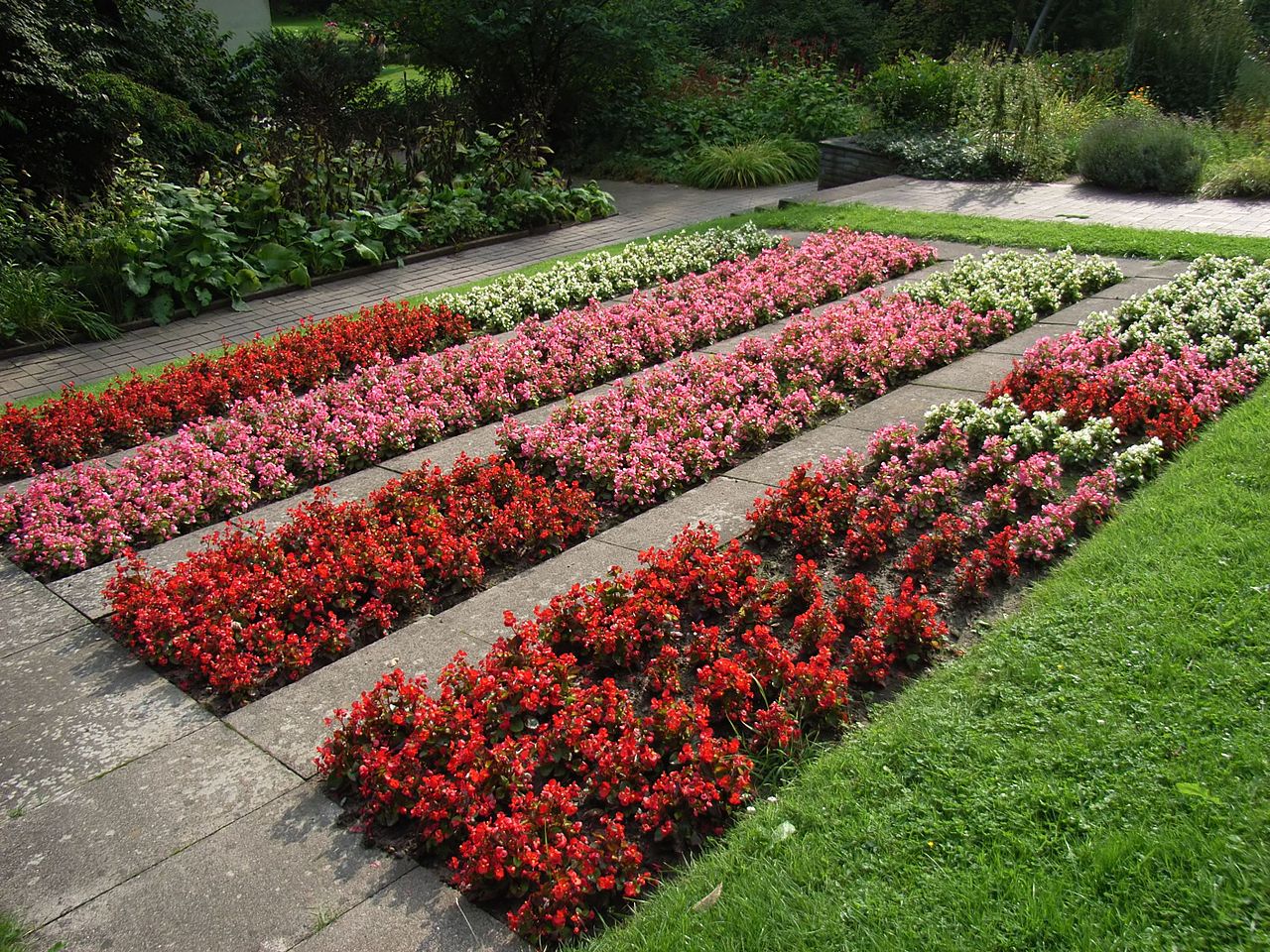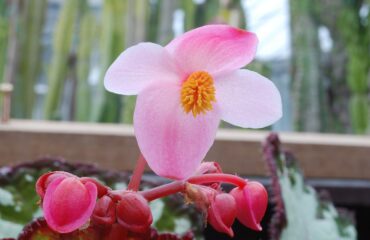Begonia semperflorens, commonly known as Wax Begonia, is a popular annual or perennial flowering plant known for its vibrant blooms and glossy, waxy leaves. Native to Brazil, Wax Begonia is widely grown in gardens and as a houseplant due to its continuous flowering and ease of care. The flowers come in a range of colors including white, pink, red, and bi-colors, often contrasting beautifully with its green, bronze, or reddish-brown foliage. Wax Begonias typically grow to a height of 6-12 inches (15-30 cm) and a spread of 8-18 inches (20-45 cm), making them ideal for borders, containers, hanging baskets, and as ground cover.
Preferred Growing Conditions:
- Soil Type: Prefers well-drained, rich, organic soil; thrives in a potting mix with peat, perlite, and vermiculite.
- Sunlight: Grows best in partial shade to full sun; in hotter climates, they prefer partial shade to protect from intense midday sun.
- Temperature: Hardy in USDA zones 10-11 as a perennial, but commonly grown as an annual in cooler climates; prefers temperatures between 60-75°F (15-24°C) and does not tolerate frost.
- Water Needs: Moderate; requires regular watering to keep the soil consistently moist but not waterlogged. Ensure good drainage to prevent root rot.
Begonia Semperflorens (Wax Begonia) Propagation Methods:
1. Seed Propagation:
Growing Begonia semperflorens from seeds is a common and effective method, especially for producing large numbers of plants for bedding displays.
- Seed Collection and Preparation:
- Collect seeds from mature flower heads after they have dried and the seeds have matured.
- Begonia seeds are tiny, so they should be handled with care. Clean and dry the seeds for a few days before planting or store them in a cool, dry place until ready to plant.
- Sowing Techniques:
- Sow seeds indoors 8-12 weeks before the last expected frost date.
- Fill seed trays or small pots with a light, well-draining seed-starting mix.
- Scatter the seeds thinly over the surface and press them lightly into the soil without covering, as they require light for germination.
- Mist the surface lightly and cover the tray with a clear plastic lid or plastic wrap to maintain high humidity.
- Place the tray in a bright location with temperatures around 70-75°F (21-24°C).
- Germination Requirements:
- Seeds typically germinate within 10-21 days under optimal conditions.
- Once seedlings emerge, gradually remove the cover to provide better air circulation.
- Keep the soil slightly moist and provide bright, indirect light.
- When seedlings have developed several true leaves and are sturdy enough to handle, transplant them into individual pots.
2. Stem Cuttings:
Propagating Begonia semperflorens from stem cuttings is a reliable method for creating new plants that retain the characteristics of the parent.
- Types of Cuttings:
- Use soft, non-flowering shoots taken from healthy, mature plants.
- Preparation:
- Select healthy, non-flowering shoots and cut 3-4 inch sections just below a leaf node.
- Remove the lower leaves, leaving only the top few leaves on the cutting.
- Rooting in Water:
- Place the cuttings in a glass of water, ensuring the leaf nodes are submerged.
- Place the glass in a bright, indirect light location.
- Change the water every few days to keep it fresh and clear.
- Roots should begin to form within 2-4 weeks.
- Rooting in Soil:
- Alternatively, insert the cuttings directly into a well-draining potting mix, such as a blend of peat and perlite.
- Water lightly to settle the soil and place the pot in a bright, indirect light location.
- Cover the pot with a plastic bag or place in a propagation tray with a clear lid to maintain high humidity.
- Transplanting:
- Once roots are well-established and new growth appears, transplant the rooted cuttings into individual pots or directly into the garden.
- Gradually acclimate the new plants to outdoor conditions if they were started indoors.
3. Leaf Cuttings:
Propagating Begonia semperflorens from leaf cuttings is another effective method, particularly useful when you want to produce multiple plants from a single leaf.
- Types of Cuttings:
- Use healthy, mature leaves for cuttings.
- Preparation:
- Select a mature, healthy leaf and cut it from the plant, including a short section of the petiole (leaf stem).
- Alternatively, cut the leaf into sections, each with a main vein. Each section can produce a new plant.
- Planting:
- Place the leaf or sections on the surface of a well-draining potting mix, such as a blend of peat and perlite.
- Lightly press the leaf or sections into the soil, ensuring good contact but without burying them.
- Water lightly to settle the soil and place the pot in a bright, indirect light location.
- Cover the pot with a clear plastic bag or place in a propagation tray with a clear lid to maintain high humidity.
- Rooting:
- New roots and shoots should begin to form at the cut veins or edges within 4-8 weeks.
- Once new growth appears and the plantlets are large enough to handle, they can be separated from the parent leaf and transplanted into individual pots.
4. Division:
Division is a straightforward and effective method for propagating Begonia semperflorens, particularly for established clumps. This method helps rejuvenate the parent plant and produce new plants with identical characteristics.
- Timing:
- The best time for division is in early spring before new growth begins or in early autumn after the active growing season.
- Method:
- Carefully remove the plant from its pot and gently separate the root ball into smaller sections, ensuring each division has several shoots and a portion of the root system.
- Use a sharp knife or garden spade to divide the root ball if necessary.
- Remove any dead or damaged roots and foliage.
- Replanting:
- Replant the divisions immediately in prepared pots filled with a well-draining potting mix.
- Plant at the same depth as the original clump, spacing divisions to allow room for growth.
- Water thoroughly to settle the soil around the roots.
- Care After Division:
- Keep the newly planted divisions well-watered as they establish.
- Place the pots in a bright, indirect light location.
- Maintain high humidity and protect from strong drafts and sudden temperature changes during the initial recovery period.
Care for Newly Propagated Plants:
- Place new plants in a location with partial shade to full sun, adjusting the light exposure based on your climate and the plant’s needs.
- Water regularly to keep the soil consistently moist but not waterlogged.
- Apply a balanced, water-soluble fertilizer every 4-6 weeks during the growing season to promote healthy growth and abundant blooms.
- Pinch back the growing tips regularly to encourage bushier growth and more prolific flowering.
- Protect from strong drafts and sudden temperature changes to prevent stress.
Common Challenges and Solutions:
- Powdery Mildew: Ensure good air circulation around plants and avoid overhead watering. Treat with fungicides if necessary.
- Root Rot: Ensure good drainage and avoid waterlogging, especially in heavy soils or poorly ventilated containers.
- Aphids and Mealybugs: Monitor for common pests and treat infestations with insecticidal soap or neem oil.
Additional Tips:
- Prune lightly after flowering to shape the plant and remove any dead or damaged branches.
- Use pots with drainage holes to prevent water accumulation and root rot when growing Wax Begonia in containers.
- Rotate pots regularly to ensure even light exposure and prevent the plant from leaning towards the light.
- Wax Begonias are excellent for adding color to shady spots in the garden or brightening up indoor spaces.
Conclusion:
Propagating Begonia semperflorens offers a rewarding opportunity to grow these vibrant and versatile plants in your garden or as houseplants. Whether you choose to start from seeds, use stem or leaf cuttings, or divide larger plants, with proper care and attention, Wax Begonias will thrive and bring continuous color and charm to your space.
Share this article



